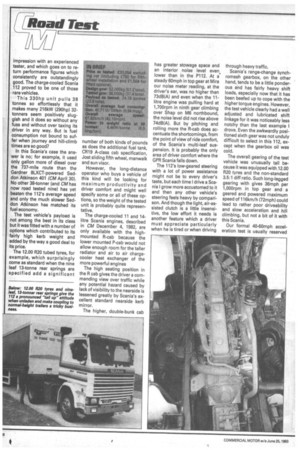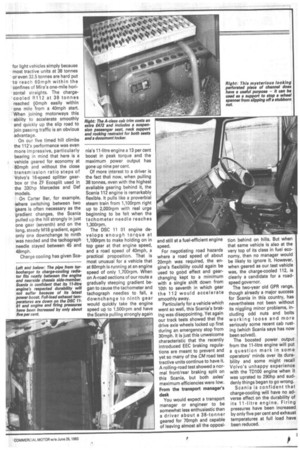Road Test
Page 40

Page 41

If you've noticed an error in this article please click here to report it so we can fix it.
impression with an experienced tester, and which goes on to return performance figures which consistently are outstandingly good. The charge-cooled Scania 112 proved to be one of those rare vehicles.
This 330hp unit pulls 38 tonnes so effortlessly that it makes many 216kW (290hp) 32tanners seem positively sluggish and it does so without any fuss and without over taxing its driver in any way. But is fuel consumption not bound to suffer when journey and hill-climb times are so good?
In this Scania's case the answer is no; for example, it used only gallon more of diesel over the 737-mile route than the Gardner 8LXCT-powered Seddon Atkinson 401 (CM April 30). No other 38-tonner (and CM has now road tested nine) has yet beaten the 112's average speed and only the much slower Seddon Atkinson has matched its fuel economy.
The test vehicle's payload is not among the best in its class but it was fitted with a number of options which contributed to its fairly high kerb weight and added by the way a good deal to its price.
The 12.00 R20 tubed tyres, for example, which surprisingly come as standard when the nine leaf 13-tonne rear springs are specified add a significant number of both kinds of pounds as does the additional fuel tank, CR19 A-class cab specification, Jost sliding fifth wheel, manwalk and sun visor.
However, the long-distance operator who buys a vehicle of this kind will be looking for maximum productivity and driver comfort and might well specify some or all of these options, so the weight of the tested unit is probably quite representative.
The charge-cooled 11 and 14litre Scania engines, described in CM December 4, 1982, are only available with the highmounted R-cab because the lower mounted P-cab would not allow enough room for the taller radiator and air to air chargecooler heat exchanger of the more powerful engines The high seating position in the R cab gives the driver a commanding view over traffic while any potential hazard caused by lack of visibility to the nearside is lessened greatly by Scania's excellent standard nearside kerb mirror.
The higher, double-bunk cab
has greater stowage space and an interior noise level even. lower than in the P112. At a steady 60mph in top gear at Mira our noise meter reading, at the driver's ear, was no higher than 73dB(A) and even when the 11litre engine was pulling hard at 1,700rpm in ninth gear climbing over Shap on M6 northbound, the noise level did not rise above 74dB(A). But by pitching and rolling more the R-cab does accentuate the shortcomings, from the point of view of ride comfort, of the Scania's multi-leaf suspension. It is probably the only area of driver comfort where the GPR Scania falls down.
The 112's low-geared steering with a lot of power assistance might not be to every driver's taste, but each time I drive a Scania I grow more accustomed to it and then any other vehicle's steering feels heavy by comparison. And though the light, air-assisted clutch is a little insensitive, the low effort it needs is another feature which a driver must appreciate particularly when he is tired or when driving through heavy traffic.
Scania's range-change synchromesh gearbox, on the other hand, tends to be a little ponderous and has fairly heavy shift loads, especially now that it has been beefed up to cope with the higher torque engines. However, the test vehicle clearly had a well adjusted and lubricated shift linkage for it was noticeably less notchy than the last example I drove. Even the awkwardly positioned sixth gear was not unduly difficult to select in this 112, except when the gearbox oil was cold.
The overall gearing of the test vehicle was unusually tall because it was equipped with 12.00 R20 tyres and the non-standard 3.5:1 diff ratio. Such long-legged gearing with gives 36mph per 1,000rpm in top gear and a geared and powered maximum speed of 116km/h (72mph) could lead to rather poor driveability and slow acceleration and hill climbing, but not a bit of it with this Scania.
Our formal 40-60mph acceleration test is usually reserved
for light vehicles simply because most tractive units at 38 tonnes or even 32.5 tonnes are hard put to reach 60mph within the confines of Mira's one-mile horizontal straights. The chargecooled R112 at 38 tonnes reached 60mph easily within one mile 'sfrom a 40mph start. When joining motorways this ability to accelerate smoothly and quickly up the slip road to join passing traffic is an obvious advantage.
On our five timed hill climbs the 112's performance was even more impressive, particularly bearing in mind that here is a vehicle geared for economy at 60mph and without the close transmission ratio steps of Volvo's 16-speed splitter gearbox or the ZF Ecosplit used in the 330hp Mercedes and Daf models.
On Carter Bar, for example, where switching between two gears is often necessary as the gradient changes, the Scania pulled up the hill strongly in just one gear (seventh) and on the long, steady M18 gradient, again only one downchange to ninth was needed and the tachograph needle stayed between 45 and 48mph.
Charge cooling has given Sea nia's 11-litre engine a 13 per cent boost in peak torque and the maximum power output has gone up nine per cent.
Of more interest to a driver is the fact that now, when pulling 38 tonnes, even with the highest available gearing behind it, the Scania 112 engine is remarkably flexible. It pulls like a proverbial steam train from 1,100rpm right up to 2,000rpm with real urge beginning to be felt when the tachometer needle reaches 1,30Orpm.
The DSC 11 01 engine develops enough torque at 1,100rpm to make holding on in top gear at that engine speed, and a road speed of 40mph, a practical proposition. That is most unusual for a vehicle that at 60mph is running at an engine speed of only 1,700rpm. When on A-road sections of our route a gradually steeping gradient began to cause the tachometer and tachograph needles to fall, a downchange to ninth gear would quickly take the engine speed up to 1,500rpm and have the Scania pulling strongly again and still at a fuel-efficient engine speed.
For negotiating road hazards where a road speed of about 20mph was required, the engine's flexibility could again be used to good effect and gearchanging kept to a minimum with a single shift down from 10th to seventh in which gear the 112 would accelerate smoothly away.
Particularly for a vehicle which went so well, this Scania's braking was disappointing. Yet again our track tests showed that the drive axle wheels locked up first during an emergency stop from 30mph. It is just this unwelcome characteristic that the recently introduced EEC braking regulations are meant to prevent and yet so many of the CM road test tractive units continue to have it. A rolling-road test showed a normal front/rear braking split on this Scania, but both axles' maximum efficiencies were low. From the transport manager's desk You would expect a transport manager or engineer to be somewhat less enthusiastic than a driver about a 38-tonner geared for 70mph and capable of leaving almost all the opposi tion behind on hills. But when that same vehicle is also at the very top of its class in fuel economy, then no manager would be likely to ignore it. However, when geared as our test vehicle was, the charge-cooled 112, is clearly a candidate for a roadspeed governor.
The two-year old GPR range, though already a major success for Scania in this country, has nevertheless not been without its niggling minor problems, including odd nuts and bolts working loose and more seriously some recent cab rusting (which Scania says has now been solved).
The boosted power output from the 11-litre engine will put a question mark in some operators' minds over its durability and some might recall Volvo's unhappy experience with the TD100 engine when it was uprated to 290hp and suddenly things began to go wrong.
Scania is confident that charge-cooling will have no adverse effect on the durability of its 11-litre engine. Firing pressures have been increased by only five per cent and exhaust temperatures at full load have been reduced.








































































































